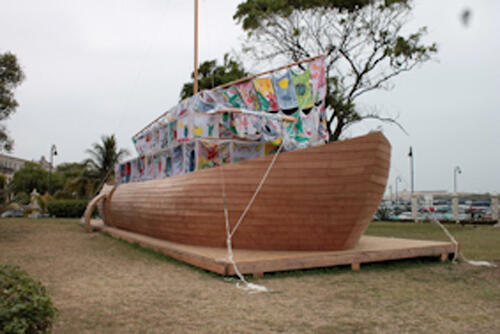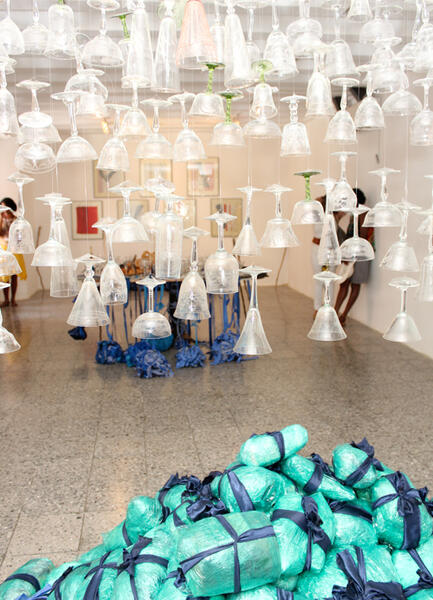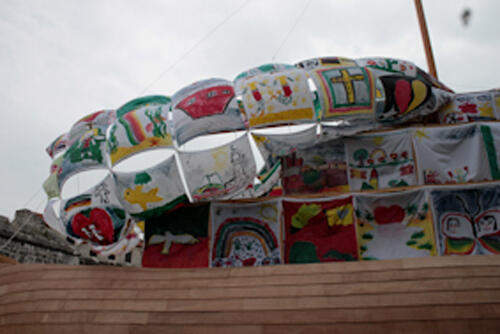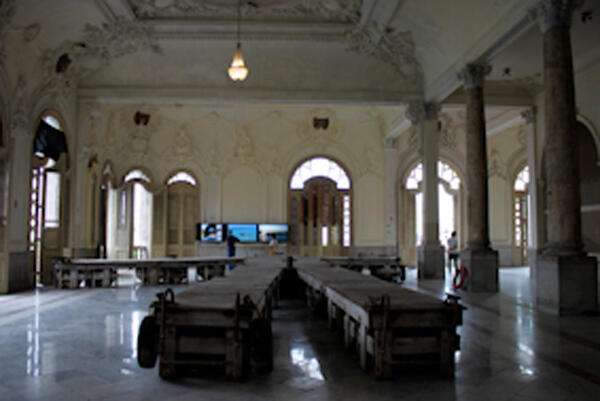Works that serve as bridges at the 11th Havana Biennial
Speaking of the 11th Havana Biennial, 11BH, devoted to Artistic practices and social imaginaries, it is not by chance that the word “bridges”, with its multiple meanings, comes to mind: “A structure providing passage, temporary floating crossings, a connection that provides continuity where an electric circuit has been interrupted, the part of a pair of eyeglasses that joins the two lenses, frequent and continuous communication established between two places in order to facilitate the movement of people and merchandises from one to the other; set of installations that are at the service of this cause at an airport:”

Four projects – those of María Magdalena Campos-Pons and Neil Leonard at the Wifredo Lam Center, Ilya and y Emilia Kavakov at the Castillo de la Real Fuerza, Kcho at Gran Teatro de La Habana, and Sandra Ramos’s, included in collateral exhibitions, may be defined as bridges. Mounted in different spaces scattered according to the Biennial’s modality, they counterbalance Slavoj Zizek´s opinion: “Since Sept. 11, at least we know that the divisions are still there and there.”
The installation featured by Campos Pons and Leonard as musician, was displayed as an open construction which included a room with two tables with ribbons tied to them and the bread supplied by “Fefa”, as she wished to call herself, playing the part of a character who listened to and recorded in the neighborhoods of Havana, what the relatives of those who had families living abroad requested from them. The artist’s country of origin (Cuba) and her place of residence (the United States) confer a specific tension to the requests, which also allude to the global explosion of the phenomenon of emigration. In any case, Fefa arrived in the Biennial bringing bags wrapped in plastic which was blue like the sea or like the suitcases arriving at US airports via Cuba and containing the things that had been requested, as attested to by the voices heard on the video screened in the background and that also included the echo of the cries of street vendors recorded in Havana, which Leonard incorporated in the sound track. This acoustic ritual of objects offered by street vendors that have recently reappeared in Havana and that were invited by the artists to participate establishes a relationship between the cries of vendors and wishes which, while involving mobility at the level of survival, also implies an elimination of distances both between art and these “artisans of language”, as Leonard defined them, and between the inhabitants of the island and the Diaspora. A curtain of transparent glasses in a tilted position as if representing an offering, whose dimensions increases as the requested items are delivered − in a documented action − and the pieces of blue ribbons with which Campos Pons would aspire to form, some day, a great ball covering 90 miles, are metaphors for the determination to gradually reduce the distance through practices that are equivalent to bringing together scattered fragments of a unit.
The Kavakovs’ The Ship of Tolerance is a project they conceived in 2005 in Siwa, Egypt, close to the Libyan border, as a dream ship connecting the children that drew motifs that were hoisted with the sails with their remote past. After being launched in Egyptian waters and visiting remote cities such as St. Moritz, Venice or Sharjah, the project was taken to Miami in conjunction with the Miami Children´s Museum and Art Basel Miami Beach. In the 11BH, this project-installation comprised of drawings made by Havanan children, master carpenters from Manchester, England, and students at the Gaspar Melchor de Jovellanos Workshop-School, was mounted at the Castillo de la Real Fuerza, with the forcefulness of the children’s words or phrases: “Tolerance”, or “Don’t hate me because I am not like you”. The ship − their first work in Cuba − will remain in the island. Even anchored, it tacitly sails the seas and covers the distances between the cities visited.
Curiously enough, the installation Puentes: entre lejanías y cercanías , created by Sandra Ramos under the curatorship of Corina Matamoros and shown at the Collateral Exhibitions Section, had as its immediate precedent the artist’s exhibition at the Miami gallery Dot Fifty One, 90 millas, Living in the Vortex, curated by Janet Batet, and it proposed the possibility of a passageway spanning the distance between the island and the shores of Florida. The visitor walked along this bridge of metal arches and light boxes that illumined the photographs taken by Ramos in the course of her flight from Havana to Miami in March, 2001. In the gallery, the installation was oriented in the opposite direction, but at the 11BH, it made up the other half, with the intention of creating “a bridge not only for the Florida Straits but for every geographical point where there is dissent. For every place where people’s passage is necessary and beneficial. For the countless spaces where man would like to try his luck, seek refuge, work or find his brothers.” They are bridges under construction, created with full awareness that only the re-humanization of the transits, the journey to otherness, can consolidate the vision of a common future.
Kcho’s (Alexis Machado) installation, El David, on the other hand, is one of his best works. It consists of a floating dock built in the shape of a human silhouette, which includes, besides wood, floating elements such as empty tanks and which, as it may be observed in the videos that accompany it, may be walked on or launched to the sea like a huge raft that facilitates human travel and may even become a ludic bridge.
To conclude, it is not idle to mention another of the exhibition projects at the Biennial. La exposición bien temperada, a performance-workshop by Pablo Helguera that theatrically unified structures of musical and verbal compositions, was presented in spaces such as the concert room at the Iglesia de Paula or the Mozart Lyceum. The experimental project followed a series of Bach exercises that sought to “translate his compositions into co-relational forms, such as verbal counterpoint, contextual harmony, or movement.” At a certain point, the phrase “I would rather be made up of paradoxes” was heard, and the spectators received a blank card that read: “In history’s concavity”. The bridges laid at 11BH inscribe in it those sorts of paradoxes in transit that reinforce director Jorge Fernández Torres’s opinion on the implications of intervening in the public space: “It is the most evident way of skirting frontiers and walking along that chalk circle that establishes the contours of permissiveness and tolerance.”
-

Llegoo! Fefa! (Detalle de la instalación)
Familia en el extranjero/Family Abroad
Crédito: Willy Castellanos
-

The Ship of Tolerence, 2011 (Detail)
Installation at Castillo de la Real Fuerza, Havana
Photo credit: Deborah Castellanos
-

The Ship of Tolerence (detail), 2012
Installation at Castillo Real de la Fuerza,
Oncena Bienal de La Habana
Photo credit: Deborah Castellanos
-

El David (2009)
Installation (Detail)
Wood, metal, cord, barrels
17,70cm x 13,40cm
Photo credit: Deborah Castellanos
-

El David (2009)
Installation (Detail)
Wood, metal, cord, barrels
17,70cm x 13,40cm
Photo credit: Deborah Castellanos




